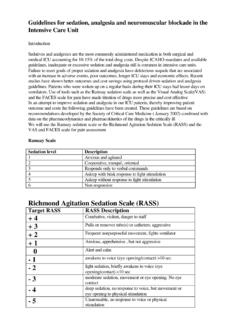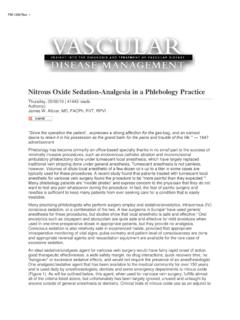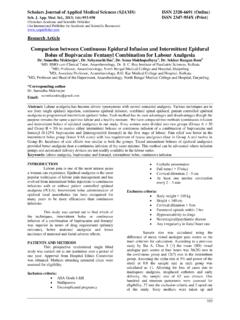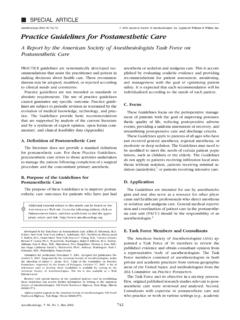Transcription of EPIDURAL INTRATHECAL INTRAPLEURAL …
1 Developed in collaboration with Corporate Education and Training 2/05, Revised 6/10 Page 1 of 14 EPIDURAL / INTRATHECAL / INTRAPLEURAL analgesia developed by Janie Best, MSN, APRN, BC, ONC Presbyterian Healthcare, Revised by Kelly Wright, RN, BSN The purpose of this self-directed learning activity is to provide the nurse with basic knowledge of anatomy and pathophysiology of the spine and an understanding of the care required for patients receiving EPIDURAL , INTRATHECAL , or INTRAPLEURAL analgesia . Objectives: 1. Describe spinal cord and pleural anatomy 2. Define EPIDURAL , INTRATHECAL , and INTRAPLEURAL analgesia 3. Discuss medications commonly used to provide analgesia 4. Identify specific nursing care required to care for this patient population Time for completion: 60 minutes (1 hour) developed in collaboration with Corporate Education and Training 2/05, Revised 6/10 Page 2 of 14 TABLE OF CONTENTS Instructions.
2 3 Anatomy and Physiology of the Spine .. 4 EPIDURAL analgesia .. 5 INTRATHECAL analgesia .. 5 INTRAPLEURAL analgesia .. 6 Preoperative Evaluation .. 7 Medications .. 7 Medication Administration .. 8 Patient 8 Catheter Site Care .. 9 Side Effects .. 9 OB Specific .. 9 Patient Education .. 9 Common Side Effects and Interventions/Treatments .. 10 Post Test .. 11 Post Test Answers .. 12 Evaluation .. 14 developed in collaboration with Corporate Education and Training 2/05, Revised 6/10 Page 3 of 14 Instructions This activity is designed for nurses who provide direct patient care for patients with orders for EPIDURAL / INTRATHECAL / or INTRAPLEURAL analgesia for pain control. The following instructions will help you proceed through this self-directed learning activity. Read all the materials in the module and complete the test at the end. Complete the criterion checklist for administration of INTRAPLEURAL analgesia , EPIDURAL / INTRATHECAL analgesia Administration, and EPIDURAL / INTRATHECAL Catheter removal as appropriate (you may have already been checked off on these skills.)
3 Your feedback regarding this activity is important to us. You will find an evaluation form at the end of this activity. We will use your feedback when the time comes to make revisions to this activity. Thank-you and we hope you find this activity helpful. 1. Complete the post test and give to your manager 2. Complete the criterion checklists for administration of INTRAPLEURAL analgesia , EPIDURAL / INTRATHECAL analgesia Administration, and EPIDURAL / INTRATHECAL catheter removal and give to your manager (if you have not already been checked off on these skills.) 3. Complete the evaluation form and return to Corporate Education. 4. Record one hour continuing education time on your annual Education Record. developed in collaboration with Corporate Education and Training 2/05, Revised 6/10 Page 4 of 14 EPIDURAL / INTRATHECAL / INTRAPLEURAL analgesia Anatomy and Physiology of the Spine The spinal column consists of 7 cervical, 12 thoracic, 5 lumbar vertebrae, and 5 fused sacral vertebrae.
4 Providing a framework to support the trunk, the spinal column also provides protection to the spinal cord. A continuation of the medulla oblongata, the spinal cord is 40 to 50 cm long and ends at L1 or L2 of the lumbar spine. Thirty-one pairs of spinal nerves exit between the vertebral foramen to enervate specific dermatomes. Additional protection of the spinal cord is provided by the meninges and the cerebrospinal fluid. The three (3) layers of meninges act to suspend and maintain the shape of position of the nervous tissue of the spinal cord. The meninges that cover the spinal cord are similar to those covering the brain and form three spaces. The subdural space lies between the dura mater and the arachnoid and is a potential space. The EPIDURAL space lies between the spinal dura and the vertebral periosteum (arachnoid). The EPIDURAL space is a true space. The interior layer is the pia.
5 Between the arachnoid and pia (subarachnoid) is the cerebrospinal fluid (CSF). Approximately 500 ml of CSF are produced in the choroid plexus of the brain each day. It is absorbed approximately at the same rate that it is produced. developed in collaboration with Corporate Education and Training 2/05, Revised 6/10 Page 5 of 14 EPIDURAL analgesia EPIDURAL analgesia is the administration of medication via catheter inserted into the EPIDURAL space at the thoracic or lumbar level or caudal level (for pediatric patients). The medication then diffuses into the subarachnoid space and cerebrospinal fluid where it binds with opioid receptor sites. EPIDURAL analgesia is used for patients following thoracic, abdominal, or lower extremity surgery. It is useful for patients with known contraindications for general anesthesia, including cardiac or respiratory disease, decreasing the incidence of complications of general anesthesia for these patients.
6 EPIDURAL anaglesia provides effective pain relief and improved pulmonary function without sedation. Medication can be administered continually or by bolus injection. Recovery time is shorter than that for general anesthesia and effects of longer-acting anesthetics and opioids will prolong the analgesic effects without accompanying sedation. INTRATHECAL analgesia INTRATHECAL analgesia is the administration of medication via catheter inserted into the subarachnoid space and cerebrospinal fluid. The most common use of INTRATHECAL analgesia is the one time bolus of analgesia before or during surgical procedures. Risk of central nervous system infection is of concern, so continuous infusions into the INTRATHECAL space are not recommended. Because the medication does not have to diffuse through membranes to reach the CSF, the medications used are about 10 times more potent than those used in the EPIDURAL space.
7 Developed in collaboration with Corporate Education and Training 2/05, Revised 6/10 Page 6 of 14 INTRAPLEURAL analgesia Pleura: Composed of a visceral layer and a parietal layer, the pleura totally enclose the lung. The visceral pleura hug the contours of the lung surface, including the fissures between the lobes. The parietal pleura line the inner surface of the chest wall and the upper surface of the diaphragm, double back, around the mediastinum, and join the visceral layer at the lung root. The space between the pleural layers, the pleural cavity, is only a potential space. A thin film of serous fluid fills this cavity, lubricating the pleural surfaces to slide smoothly against each other while creating a cohesive force between layers. This compels the lungs to move synchronously with the chest wall during breathing. Image Source: developed in collaboration with Corporate Education and Training 2/05, Revised 6/10 Page 7 of 14 INTRAPLEURAL analgesia : The administration of medication via a catheter inserted between the parietal and visceral pleura of the lung.
8 The local anesthetic then diffuses across the parietal pleura to relieve pain by blocking intercostal nerve roots. INTRAPLEURAL analgesia is used for patients following thoracic surgery or for those with multiple rib fractures who have painful and ineffective breathing. Another use for INTRAPLEURAL anaglesia is to provide pain relief for patients with acute pancreatitis whose pain has not been managed by other pharmacologic interventions. The most common medications administered by this method are local anesthetics such as bupivacaine. The injection may be bolus or continuous. Preoperative Evaluation Patients are evaluated for EPIDURAL , INTRATHECAL , and INTRAPLEURAL analgesia by the anesthesiologist. Indications for use are based on the surgical procedure, spinal anatomy, and skin condition. Absolute contraindications for use of EPIDURAL or INTRATHECAL analgesia include the presence of infection at the site of needle insertion, presence of coagulopathies, increased intracranial pressure, or patient refusal of the procedure.
9 Elevated INR or PTT at the time of needle insertion greatly increase the risk of the development of EPIDURAL hematoma. Relative contraindications include hypovolemia, sepsis, or preexisting neurologic disease. Any hypovolemia must be corrected prior to needle insertion to avoid severe hypotension related to sympathetic denervation. Sepsis is thought by some to increase the risk of introduction of bacteria into the CSF. Any preexisting neurologic deficits must be carefully documented to allow for accurate postoperative assessment. Medications Drug choice is based on the use (operative, or postoperative), and by the drug s properties. All medications used for EPIDURAL or INTRATHECAL analgesia must be preservative free. Medication preservatives can be neurotoxic and may cause spinal cord injury. In addition, alcohol is potentially neurotoxic and may not be used to clean vial tops or injection ports.
10 Alcohol packets may not be used to protect the fingers when opening vials. The most common opioids used for EPIDURAL / INTRATHECAL analgesia are preservative-free Morphine (Astramorph), Hydromorphone (Dilaudid), and Fentanyl. Spinal administration of these opioids provides selective blocking of opioid receptors and preserves intact sensation, motor, and sympathetic function. Spinal opioids have longer duration, so less medication is needed to achieve the desired analgesic effect. Dose, onset, peak, and duration of the most commonly used medications are listed in Table 1. OPIOID DOSE ONSET PEAK DURATION Morphine 4 8 mg 20 30 minutes 30 60 minutes 4 24 hours Hydromorphone 1 3 mg 10 20 minutes 20 30 minutes 5 15 hours Fentanyl 50 100 micrograms 5 15 minutes 10 20 minutes 2 4 hours Table 1 Opioids Used in EPIDURAL / INTRATHECAL analgesia developed in collaboration with Corporate Education and Training 2/05, Revised 6/10 Page 8 of 14 Medication Administration Verify medication orders prior to administration.

















